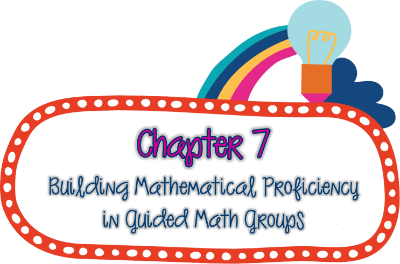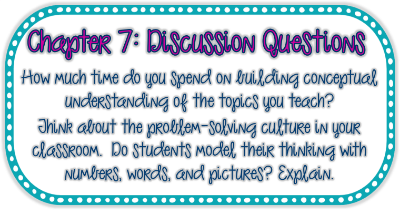
Chapter 7 of Guided Math in Action looks at the opportunities teachers have to build mathematical proficiency while having small groups. The chapter is broken down into five sections. These include:
- Conceptual understanding
- Procedural fluency
- Strategic competence
- Adaptive reasoning
- Mathematical disposition
Let's examine each one briefly.
Conceptual Understanding. Conceptual understanding is when students know what they are doing on a conceptual level. This is often what we teach in our small groups. Dr. Newton give the example of using coins to help teach dividing decimals. There is also a sample lesson that shows how one teacher used this strategy, giving students 28 pennies and asking them to put the pennies into 4 groups. This portion is where manipulatives and the teacher toolkit comes into play.
Procedural Fluency. Procedural fluency is knowing how to do mathematical procedures. It is when the students know how to do math. The example that is given in the text is adding numbers with 8 (a concept that I am totally going to "steal"). Students know the procedure of adding 2 to a number that ends in 8 to help make the number friendlier.
Strategic Competence. Strategic competence is when students are able to solve a problem and then explain their thinking as to how they were able to solve that problem. Students don't just jump straight for the answer, but they can show someone what they did to solve that particular problem. This can include using number lines, grids, or arrays. It is important for students to have a number of different ways to solve a problem.
Adaptive Reasoning. Adaptive reasoning is when students can think logically about math and then explain and justify why they chose that specific course of action. These mathematical discussions should allow the students to talk in an environment where they know their thoughts have value and they will not be made fun of because of the way they did a problem.
Mathematical Disposition. This area focuses on what students believe about math. How many students do you have that believe they are bad at math? As teachers, we need to promote perseverance, so that students will understand that some problems just take longer to solve. This involves scaffolding and helping student to stick with a problem or concept. Reflection is also a big part of this area.

I am only going to focus on answering the second question today. In my math classroom, we focus a lot on problem-solving. One of the key aspects is what we call the "Wrap Up." The Wrap Up is a concluding question (based on the day's lesson) in which students are asked to explain their thinking about a particular question. They are given the opportunity to solve the problem using words, numbers, or pictures. At the beginning of the year, the vast majority of the students will write one or two words. As the year progresses and the students become more adept at answering and solving math problems, their thinking becomes more elaborate and I begin to see longer explanations and pictures to illustrate their thinking. Of course, this type of thinking requires a good deal of scaffolding. Many third grade students try to take the easy way out when it comes to math, so building their perseverance is a huge part of teaching.
Be sure to join us on Sunday for Chapter 8.

Enjoyed reading about how you "wrap up"! :0)
ReplyDeleteSarah